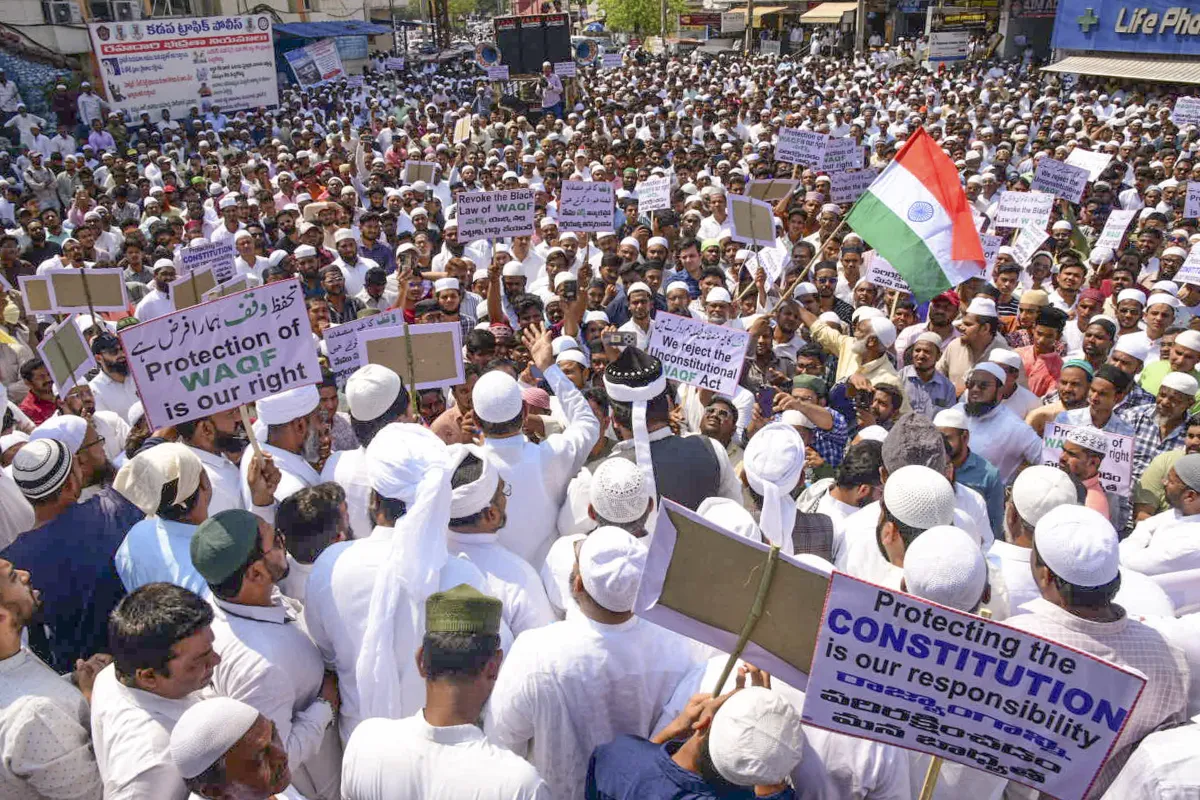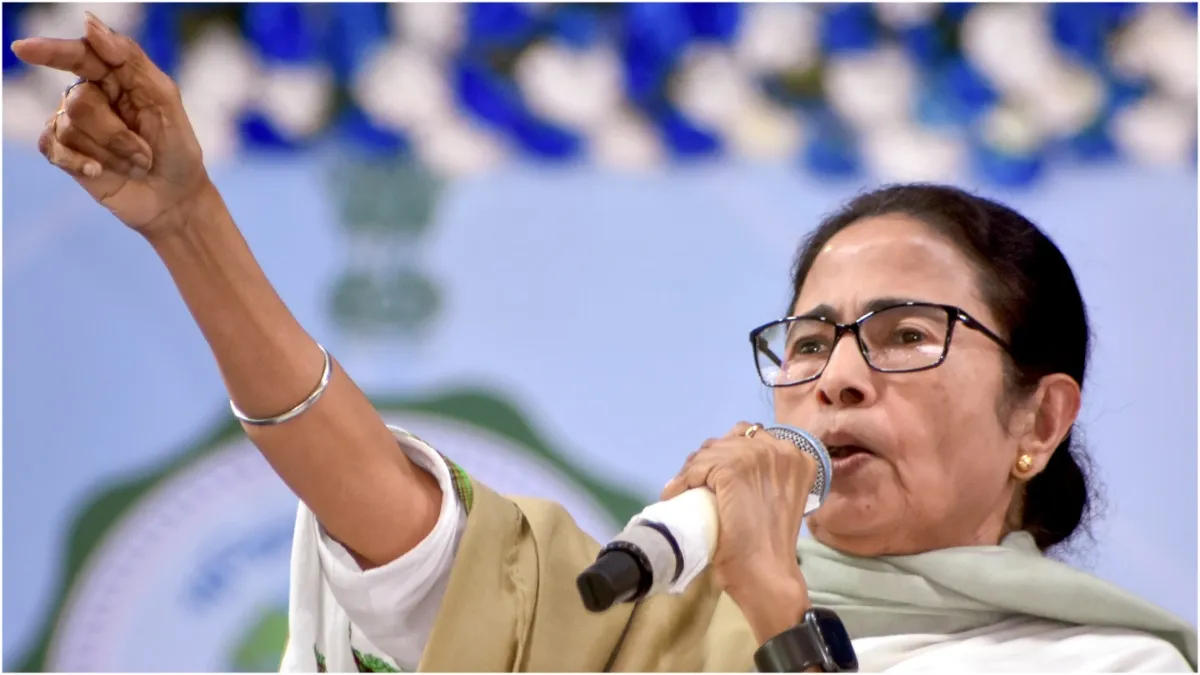Murshidabad Waqf Act Protest Turns Violent: Police Vehicles Torched Amid Unrest | Full Report
Introduction:
West Bengal: The district of Murshidabad in West Bengal became the scene of significant unrest as protests against perceived issues surrounding the Waqf Act, 1995, escalated dramatically, culminating in violence and the torching of police vehicles. What began as a demonstration by groups expressing grievances against the Act’s provisions and implementation spiralled into chaos, highlighting deep-seated concerns and the volatile nature of disputes involving land, property, and religious law in India. This incident not only raises serious questions about law and order in the region but also brings the controversial aspects of the Waqf Act back into sharp focus, demanding a closer look at the legislation, the reasons for the protest, and the ramifications of such violent outbreaks. This comprehensive report delves into the details of the Murshidabad incident, the intricacies of the Waqf Act, the specific points of contention, and the broader context surrounding this alarming event.
The Incident in Detail: Protest Descends into Violence
Reports emerging from Murshidabad paint a grim picture of the day’s events. According to initial accounts, a significant number of protesters gathered in a specific area of the district (exact location details pending confirmation) to voice their opposition to the Waqf Act. The protest, reportedly organized by a coalition of local groups and activists critical of the Act, aimed to draw attention to alleged injustices and demand legislative changes or specific administrative actions.
Eyewitnesses suggest the protest was initially planned as a peaceful demonstration. However, the situation rapidly deteriorated. Tensions flared, allegedly leading to confrontations between the protesters and the police contingent deployed to maintain order. The exact trigger for the violence remains under investigation, with conflicting accounts likely to emerge. Some reports suggest attempts by police to disperse the crowd led to resistance, while others might point towards provocative actions from elements within the protesting group.
The situation took a dangerous turn when segments of the crowd reportedly engaged in stone-pelting directed at law enforcement personnel. The violence escalated significantly when police vehicles, including jeeps used for patrol and personnel transport, were targeted. Several vehicles were allegedly surrounded, vandalised, and ultimately set ablaze, sending thick plumes of smoke into the air and signalling a complete breakdown of order.
Police reportedly responded with force, potentially employing lathi charges (baton charges) and tear gas shells to disperse the volatile crowd and regain control of the situation. Clashes between protesters and police continued for some time, resulting in injuries on both sides, although official figures on casualties and the extent of injuries are awaited. The administration moved swiftly to deploy additional police forces and paramilitary units, if necessary, to quell the violence and prevent its spread. There are reports of several arrests being made in connection with the rioting and arson. The area remains tense, with a heavy police presence likely to continue as investigations commence.
Understanding the Waqf Act, 1995: Context is Key
To comprehend the root causes of the Murshidabad protest, it’s essential to understand the Waqf Act itself.
- What is Waqf? In Islamic law, Waqf refers to the permanent dedication of movable or immovable properties for religious, pious, or charitable purposes as recognized by Muslim law. Once a property is declared Waqf, it is considered owned by God, and its usage is perpetually reserved for the intended purpose. The dedicator (Waqif) loses ownership.
- The Waqf Act, 1995: This Act was enacted by the Parliament of India to provide for the better administration of Waqf properties and related matters. It replaced earlier state-level legislations and aimed to streamline the management and supervision of Waqf properties across the country.
- Waqf Boards: The Act mandates the establishment of State Waqf Boards (and a Central Waqf Council for advisory purposes). These boards are statutory bodies responsible for the general superintendence of all Waqfs in a state. Their key functions include:
- Surveying and identifying Waqf properties.
- Registering Waqf properties.
- Ensuring Waqf properties are used for their intended purposes.
- Managing and administering these properties, including leasing or renting them out to generate income for charitable purposes.
- Investigating and resolving disputes related to Waqf properties.
- Instituting legal proceedings to recover lost or encroached Waqf properties.
- Key Powers and Provisions: The Act grants significant powers to Waqf Boards, including the authority to determine whether a property is Waqf property (Section 40), power to investigate and potentially reclaim properties believed to be Waqf, and the establishment of Waqf Tribunals (Section 83) to adjudicate disputes related to Waqf properties.
The Controversy: Why Are People Protesting the Waqf Act?
The Waqf Act, 1995, particularly after amendments in 2013, has been a subject of recurring controversy and criticism from various quarters. The protests, like the one in Murshidabad, often stem from one or more of the following concerns:
- Vast Powers of Waqf Boards: Critics argue that the Act grants excessive and potentially arbitrary powers to Waqf Boards. The power to survey and declare any property as Waqf property (even those belonging to non-Muslims or the government, according to some interpretations and criticisms) is a major point of contention. Concerns exist that these powers can be misused to claim ownership over land and properties without adequate checks and balances.
- Section 40: This section allows the Board to decide if a property is Waqf property based on its investigation. Critics argue this gives the Board quasi-judicial powers without sufficient oversight or the need for conclusive proof initially, placing the burden of proof on the current owner to challenge the Board’s claim in a Tribunal.
- Section 83 and Waqf Tribunals: While meant to expedite dispute resolution, critics argue that these tribunals, which have exclusive jurisdiction over Waqf matters, oust the jurisdiction of civil courts in many instances. There are concerns about the perceived fairness and impartiality of these specialized tribunals and the lengthy process involved in challenging their decisions.
- Allegations of Encroachment and Mismanagement: Ironically, while the Act aims to protect Waqf properties, there are also persistent allegations of mismanagement, corruption, and encroachment by or under the supervision of some Waqf Boards themselves. Conversely, some groups protest alleging that Waqf Boards are not doing enough to reclaim encroached properties belonging to the Waqf.
- Applicability to Non-Muslims: A significant point of debate is whether the Act’s provisions, particularly regarding property determination, unfairly affect non-Muslim property owners who may suddenly find their land claimed as Waqf. The fear is that historical claims, sometimes centuries old, could be revived without robust evidentiary requirements.
- Lack of Uniformity and Transparency: Concerns are often raised about the lack of uniform procedures across different State Waqf Boards and perceived opacity in their functioning and decision-making processes.
- Constitutional Challenges: The Act has faced legal challenges questioning its constitutional validity, arguing it violates principles of equality (Article 14) and the right to property (Article 300A) by creating a special regime for properties based on religion.
The specific grievances of the Murshidabad protesters likely revolve around one or more of these issues, potentially triggered by a recent survey, a specific property dispute, or a broader campaign against the perceived overreach of the local Waqf Board or the Act itself.
Murshidabad: A District with History and Sensitivity
Murshidabad holds significant historical importance. It was the capital of Bengal during the Mughal era before the British shifted the capital to Calcutta. The district has a substantial Muslim population, making issues related to Waqf particularly relevant and potentially sensitive. Its socio-political landscape is complex, often reflecting the broader political dynamics of West Bengal. Any incident involving religious law or inter-community property rights in such a district carries the risk of flaring up tensions if not handled carefully by authorities and community leaders. The choice of Murshidabad for such a protest, whether spontaneous or planned, underscores the local resonance of the Waqf Act controversy.
The Protesters: Who Are They and What Are Their Demands?
Identifying the specific groups behind the Murshidabad protest is crucial for understanding the nuances of their demands. While initial reports might be general, investigations will likely reveal whether the protest was led by established organizations (political, social, or religious), local action committees formed over specific grievances, or a more spontaneous uprising.
Their demands likely centre on:
- Repeal or Amendment: Calls for significant amendments to the Waqf Act, 1995, particularly the controversial sections granting extensive powers to the Boards. Some groups might advocate for a complete repeal.
- Judicial Oversight: Demands for greater judicial oversight over the functioning of Waqf Boards and Tribunals, potentially restoring the jurisdiction of civil courts in certain matters.
- Transparency and Accountability: Calls for increased transparency in the identification, notification, and management of Waqf properties.
- Addressing Specific Grievances: Protests could be linked to specific local disputes where properties have been allegedly wrongly identified or claimed as Waqf land.
Reactions and Responses: Condemnation and Calls for Calm
Events like the one in Murshidabad typically elicit a range of reactions:
- Police and Administration: The immediate focus is on restoring law and order, investigating the violence, identifying perpetrators (especially those involved in arson and attacks on police), and registering FIRs. Senior police officials and district administrators would likely issue statements appealing for peace, warning against rumour-mongering, and assuring a thorough probe. Security measures would be heightened.
- State Government: The West Bengal government would be under pressure to respond decisively. This could involve statements from the Chief Minister or relevant ministers condemning the violence, promising action against culprits, potentially ordering a high-level inquiry, and possibly engaging with representatives of the aggrieved communities (both protesters and those potentially affected by the Act).
- Political Parties: Opposition parties might criticise the state government for alleged failures in maintaining law and order or for not addressing the underlying issues related to the Waqf Act. The ruling party would likely defend its handling of the situation and potentially blame external elements or provocateurs for the violence. The issue could become a political flashpoint.
- Community and Religious Leaders: Leaders from various communities would likely issue appeals for calm and restraint, condemning the violence while potentially acknowledging the need to address the protesters’ concerns through dialogue and legal channels.
- Waqf Board: The relevant State Waqf Board might issue a statement clarifying its position, defending its actions under the Act, or condemning the violence while possibly expressing willingness to engage in dialogue regarding specific grievances.
Wider Implications: Beyond Murshidabad
The violent protest in Murshidabad has implications that extend beyond the immediate locality:
- Communal Harmony: Incidents involving religious laws and property rights, especially when they turn violent, carry the risk of straining communal relations. Misinformation and rumour-mongering can exacerbate tensions.
- Law and Order: The attack on police personnel and destruction of public property are serious law and order challenges, potentially emboldening disruptive elements if not dealt with firmly.
- National Discourse on Waqf Act: Such events bring national attention to the ongoing debate surrounding the Waqf Act, potentially intensifying calls for its review or amendment by the central government.
- Potential for Copycat Incidents: Violence in one location can sometimes inspire similar actions elsewhere if the underlying grievances are widespread. Authorities in other sensitive areas might increase vigilance.
- Need for Dialogue and Reform: The incident underscores the urgent need for constructive dialogue between stakeholders – government, Waqf Boards, critics of the Act, legal experts, and community representatives – to address the contentious issues surrounding the Waqf Act and find solutions that are just, equitable, and constitutionally sound.
#WATCH | Jharkhand: Following the incidents of violence in Murshidabad, security tightened at Jharkhand-West Bengal border. Visuals from Pakur, located on the border. pic.twitter.com/fWPQI6QkkD
— ANI (@ANI) April 11, 2025
Conclusion: A Symptom of Deeper Issues
The violence in Murshidabad is a stark reminder of the complexities and sensitivities surrounding the Waqf Act, 1995. While violence and destruction of property are inexcusable and must be dealt with firmly under the law, the incident also serves as a critical signal that the grievances and concerns regarding the Act’s provisions and implementation cannot be ignored. It highlights a trust deficit and a perception of potential injustice among certain sections of the population. Moving forward, a multi-pronged approach is necessary: ensuring swift justice for the violence, conducting a transparent investigation into the triggers, and, most importantly, facilitating an open and inclusive dialogue at both state and national levels to address the contentious aspects of the Waqf Act. Ignoring the underlying issues risks further unrest and polarization, making constructive reform and clear, equitable application of the law paramount. The path forward requires balancing the protection of legitimate Waqf interests with the fundamental property rights and legal protections guaranteed to all citizens.
Disclaimer: This article is based on the user’s prompt describing an event. While structured to be comprehensive, specific details (like exact locations, names of groups, casualty figures, specific trigger) would depend on actual real-time reporting if such an event occurred. The analysis of the Waqf Act and its controversies is based on publicly known debates and legal discussions surrounding the legislation.
Read Also:- Locky Win



